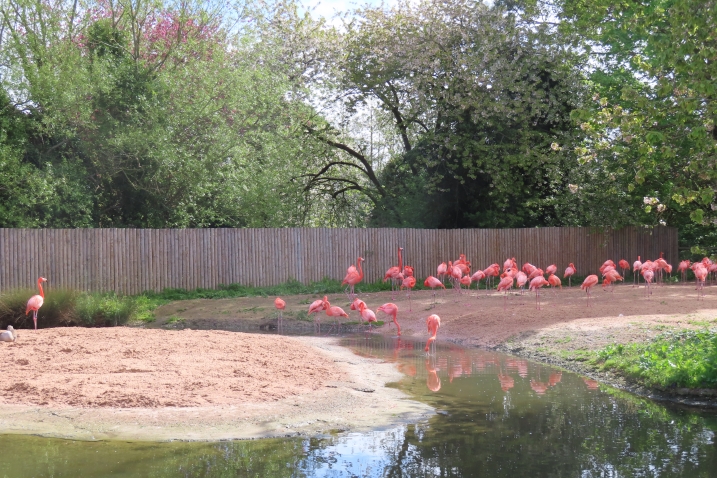Flamingos like it when the sun shines
Why is sunshine so important to flamingo behaviour? Find out more about how the sun brings out a range of flamingo feeding forays and lets them enjoy themselves just that extra bit more...

Sunshine. We love it on our summer holidays. And flamingos love it on their nesting grounds too. We were basking in a heatwave over the past couple of weeks here in the UK and this is the perfect weather for flamingos too. Whilst not all species come from tropical parts of the world, the wetlands they live in are exposed and under the glare of the full sun. Consequently, flamingos love the heat and they like to be in direct sunlight when we house them in human care. Click through the links in the text to see the different forms of activity flamingos are likely to be doing more when it's hot and sunny.

Phil feeds the Caribbean flamingos on their specially formulated flamingo pellet under the blue skies of a balmy summer afternoon. Perfect flamingo weather!
We can use evidence, i.e. data that we gather on the birds we look after, as well as the birds in the wild, to design enclosures that provide flamingos with the abilities to perform the same behaviours as they would do in the wild. For example, we can collect information on different flamingos flocks in captivity that show us the highest activity is seen in flocks whose enclosure have exposure to the most sunshine, and we can compare information on wild bird and captive birds to see how our zoo-housed flamingos organise their time.
You can see in the clip that the natural habitats so loved of free-living flamingos are open expanses baked by the full glare of the sun. Flamingos can easily cope with such conditions because it's where they are most likely to find food and suitable nesting sites.
Flamingos love to splash around searching for tasty bits of food in their enclosures. Whilst they get provided with a bespoke flamingo pellet, the instinctive filter feeding behaviours are never far under the surface. It's really important that captive flamingos get access to large pools, with varying depths of water and gloopy, soft mud too, to perform filter feeding. Watch the WWT Slimbridge greater flamingos really enjoy the mud on their island when it's been soaked with pond water.
The pools that the flamingos live in can abound with life in the summer. Microscopic plant and animal material that blooms in the warmed waters, fed by the poop of the birds that dabble and swim in the ponds and lakes, and this is perfect flamingo food. Living collection manager, Phoebe, captured me this great video of the Daphnia (tiny water fleas) that flamingos love to snack on. Clouds of Daphnia appear quickly when the water warms up, and can remain around for a long time, keeping the birds occupied and amused throughout long summer days.
Flamingos will collect this food in different ways. They can filter feed with their heads almost floating on the water's surface, they can sift through the mud on the bottom of their pool to hoover up food.

Delicate filter feeding for tasty treats at the water's surface.

Getting stuck in down in the mud. Something edible is bound to around somewhere...?!
Flamingos will also vigorously stamp their feet up and down to stir up the water, which in turns stirs up food, which they can then gobble up. The stamp feeding is definitely one of my favourite flamingo behaviours to sit and watch. The birds really do look like they are enjoying themselves and it's great when you see more than one bird stomping on the spot, spinning around in a circle in sync with its chums.
Flamingos have an intricate feeding anatomy packed into their distinctive curved bills. Compare this historic anatomical drawing of the bills of Andean and James's flamingos with the birds that you can see in person at WWT Slimbridge. Andean and James's flamingos have very deeply curved bills, much more so than the greater or Caribbean flamingo. This allows them to be even more precise in how they collect food from the water column and hence they can sieve for very tiny microorganisms that we might fail to see with the naked eye.

Compare bills... bulging and bulbous in the Andean flamingo and Mr James. Perfect for refined, fine-scale sieving.
All of this extra sunshine and readily available food means the flamingos can work less hard on what we call "maintaining homeostasis", performing behaviours that keep their body functioning normally (preening, bathing, foraging, things like that). Less energy is spent on keeping warm, like they would have to do in the wintertime. So they have extra energy available for other behaviours; dancing, finding partners, nesting. The sunshine and warm days means they have time to spare for these romantic activities too ;-)




